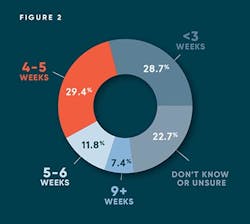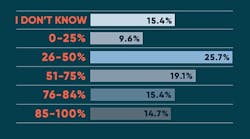After the First Industrial Revolution at the turn of the 19th century, there have been three subsequent Industrial Revolutions, and the modern plant floor looks nothing like it used to.
Today’s Fourth Industrial Revolution has seen the rise of the Internet of Things; the plant floors that we know today are filled with technology and interconnected machines. This latest revolution that we’re currently experiencing (also called “Industry 4.0” and the Industrial Internet of Things, or IIoT) is all about harnessing that data and communication – and it requires a modern maintenance routine to keep our assets working together.
Our plant floors are more high-tech than ever – which means that we need high-tech tools and technology to help us care for our assets. With valuable best practices and insightful metrics, you can use these tips to create a plan for success with a focus on overall equipment effectiveness (OEE) and extending the life of your machines
Advanced Maintenance & Technology
Proactive, or preventive, maintenance (PM) is absolutely necessary; without it, you’re essentially running your machines to failure. And, while PM is a great step toward proactively maintaining your assets (and reducing downtime in your production schedules), the next step toward true efficiency is to harness the data in your machines with predictive maintenance (PdM).
With PdM, you can automate condition monitoring processes and many others with the use of sensors and machine-to-machine (M2M) communication. A well-designed PdM program analyzes historical data and real-time information so you capture a more detailed picture of your assets’ working lives, and it doesn’t require downtime to do so.
But PM and PdM can’t exist without data, something that many manufacturers are lacking. In a recent survey of maintenance professionals, nearly 31 percent stated they know their ratio of reactive to proactive work, and 28 percent weren’t sure how much work they had in their backlog.
That’s why it’s important to have a tool that not only organizes work orders, but automatically provides you with valuable data that helps your team continuously improve.
Key Components of Modern Maintenance
Each manufacturer’s needs are different. With that in mind, there are key outcomes that are absolutely (and universally) necessary when developing a new modern maintenance plan:
- Automated workflows
- Easy, detailed reporting
- Accurate forecasting for budgets
- Information on the go (with mobile)
3 Key Metrics for Maximizing OEE
Here are three key ways you can help maximize your overall equipment effectiveness, or OEE.
Metric 1: Backlog
In an ideal world, every work order would be proactive, and we’d never have to worry about our machines when we go home at night. But the reality is that unplanned downtime can, and will, happen, and we’ll always have a backlog of maintenance as we try to catch up.
In a study with Plant Services, we found that the majority of respondents (nearly 29 percent) have 3-4 weeks of backlogged maintenance, while many others have a backlog larger than that (see graph below).
While you most likely have accrued a long backlog due to performing maintenance, it’s typically a symptom of a larger issue. The key is to look into the data in your CMMS and find the culprit, and there may be many factors.
Metric 2: Inventory Stock Outs
“Stock out” occurs when you don’t have the part when you need it, and it’s more common than you think. We found that the majority (34.6 percent of respondents) experience stock outs up to 25 percent of the time – that is, the likelihood of a technician needing a part that isn’t in stock is one in four (see graph below).
A CMMS with a just in time (JIT) inventory option is a valuable asset. With this technology, you can have better control over what’s in your inventory. JIT supplies you with the parts you need for your assets as you need them.
Metric 3: The 80/20 Rule
Everyone balances reactive with proactive work, but what’s the right ratio?
Ideally, you should aim for the “80/20 Rule” – that is, 80 percent proactive and 20 percent reactive. This is the target metric for stability; while you shouldn’t expect to get to this level immediately, it’s still a valuable benchmark to have as a long-term goal.
In our study, the majority of the respondents said they have a 50/50 split between reactive and proactive. And, most respondents said that they adhered to their planned maintenance routine 26 to 50 percent of the time (see below graph).
The important thing to remember is that while you’ll still have reactive work, you can plan for it by making sure you have the right people for the job (with the right skill set), the proper tools and all the parts you need in your inventory.
A Plan for Continued Success
So how do you get started identifying areas for improvement, and how can you ensure that you follow through?
The key to continued success is to look at improvements as a cycle with five parts:
- ASSESS- Find the root cause of what’s holding you back in improving your operations
- PRIORITIZE- Outline your priorities and make some clear, actionable goals
- PLAN- Plan out how you will achieve those goals and get buy-in from other stakeholders
- EXECUTE- Put your plans into action to streamline your workflows and gather data as you go
- MAINTAIN- The key to continued success is to reassess your progress as a cycle and measure your accomplishments and find ways to improve your processes
Keep Your Eyes on the Prize
Many manufacturers already have an idea of where they can improve, but it’s that next step toward creating a plan and executing it that can be a challenge. That’s why it’s so important to have your team on your side. It’s also important to keep your eye on the prize, and that involves setting realistic expectations.
Look for a vendor who will work with your team on achieving your goals and help you develop as a maintenance professional, so you can own your modern operations.
Click here to download the full guide to Kick-Starting Your Modern Maintenance Program for Manufacturing.




